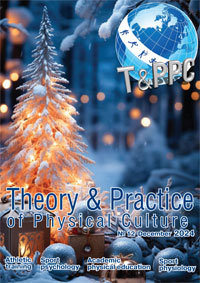Development of coordination and speech abilities of children with speech disorders
Keywords:
children with speech disorders, coordination qualities, speech development, neuro-kinesiological games and exercises, breathing exercises.Abstract
Relevance. Currently, the number of speech disorders in primary school children is steadily increasing.
According to the results of the annual survey of children in the Republic of Tatarstan, there is a tendency to increase the number of students with general speech underdevelopment. For example, in the 2015-2016 academic year, 46% of children with speech disorders were identified from the total number of applicants, in the 2019-2020 academic year - 48% of children, in the 2021-2022 academic year – 52% of children, and in 2023-2024 - 54% of the total number of applicants. The constant growth in the number of children with developmental disabilities highlights the importance of correctional and preventive work
in schools. Therefore, the development of physical qualities and speech correction is currently an urgent topic [1].
The purpose of the study: is to theoretically and experimentally substantiate the methods of adaptive physical education of younger schoolchildren with speech disorders through the use of neuro-kinesiological games, special and breathing exercises.
The results of the study and their discussion.
The results of the study and their discussion. Taking into account the identified features of the development of coordination abilities and speech, a method of adaptive physical education of younger schoolchildren with speech disorders has been developed, consisting of six interrelated blocks: Block I – neurokinetic exercises without objects, block II - neurokinetic exercises with small balls with spikes, block III – neurokinetic exercises with large balls on a balancing board of Bilgu,
block IV - neurokinetic games, block V - breathing exercises, block VI - relaxation and stretching exercises.
The experimental technique was tested in a pedagogical experiment for 12 months. At the end of the pedagogical experiment, the indicators characterizing the prosodic side of speech (reproduction of rhythm, intonation, tempo of speech) improved in the control group from 26.3% to 31.8%, in the experimental group - from 76.1% to 83.3%. Kinesthetic practice increased
in both study groups of children with dysarthria: in the control group - by 35.2%, in the experimental group - by 93.7%. A study of dynamic coordination of articulatory movements in children with dysarthria in both groups after the experiment showed improved results in both groups. The increase was higher in the experimental group (1.9 points (126.6%)) compared with the
control group - 0.6 points (37.5%). During the pedagogical experiment, the estimates of the kinetic basis of hand movements in the control and experimental groups also improved by 0.4 points (26.6%) and 1.8 points (128.6%), respectively. An improvement in EG results was also observed in indicators assessing the state of coordination abilities, from 22% to 67%.
Conclusion. Thus, the introduction of an experimental technique using neurokinetic exercises and games in extracurricular activities allowed us to establish significant differences between the groups in all the tested indicators, the increase in the experimental group ranged from 21% to 40 %.
References
Kasmakova, L. E. Neuro-kinesiological exercises and games in the development of coordination and speech abilities of younger schoolchildren with speech disorders / L. E. Kasmakova / / science and sport: current trends. – 2024. – Vol. 12, No. 1. pp. 136-143. – DOI 10.36028/2308-8826-2024-12-1-136-143. – EDN MGMBOE.
Additional Files
Published
Versions
- 12-02-2025 (3)
- 12-02-2025 (2)
- 12-02-2025 (1)
How to Cite
Issue
Section
License
Copyright (c) 2025 Theory and Practice of Physical Culture

This work is licensed under a Creative Commons Attribution 4.0 International License.

